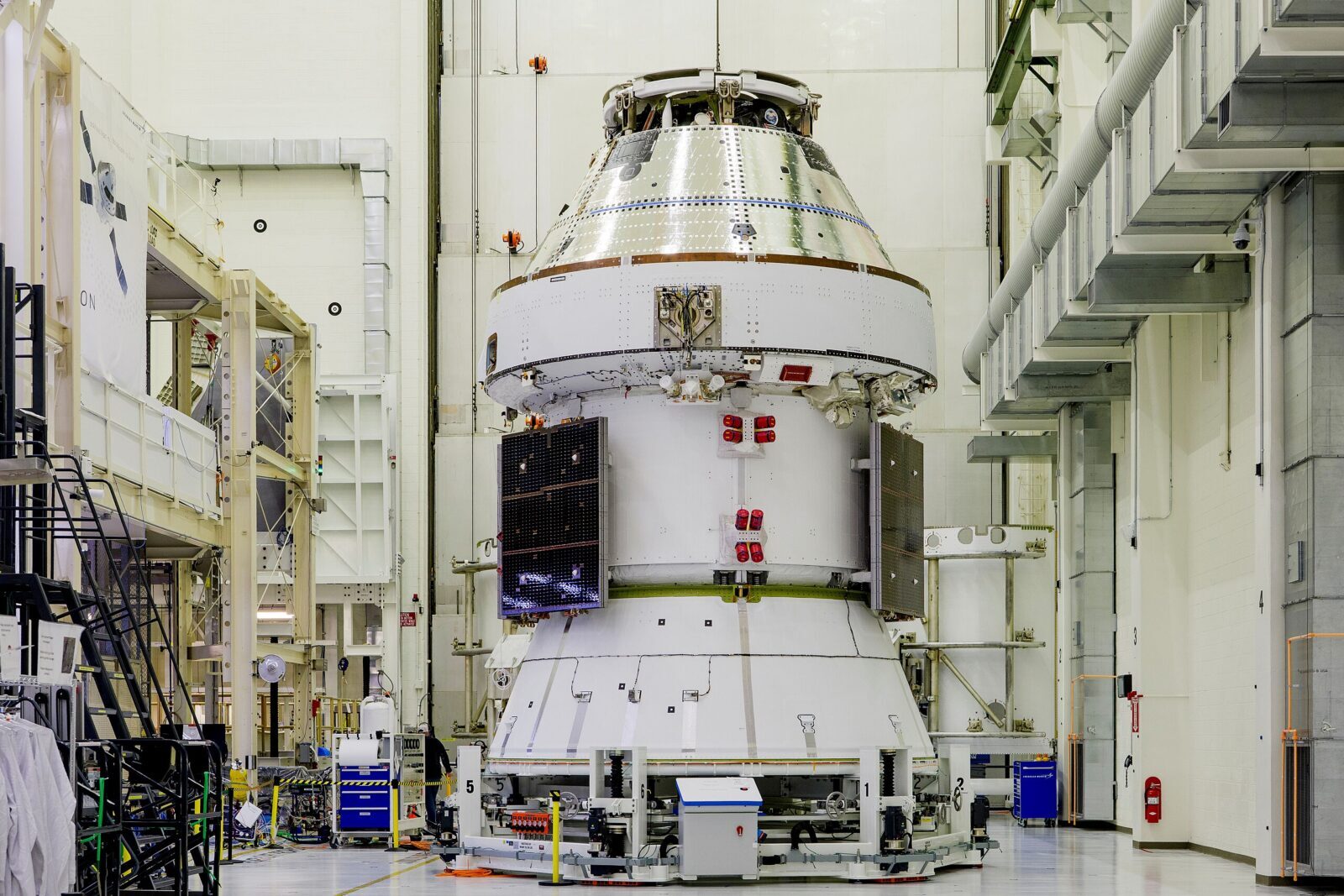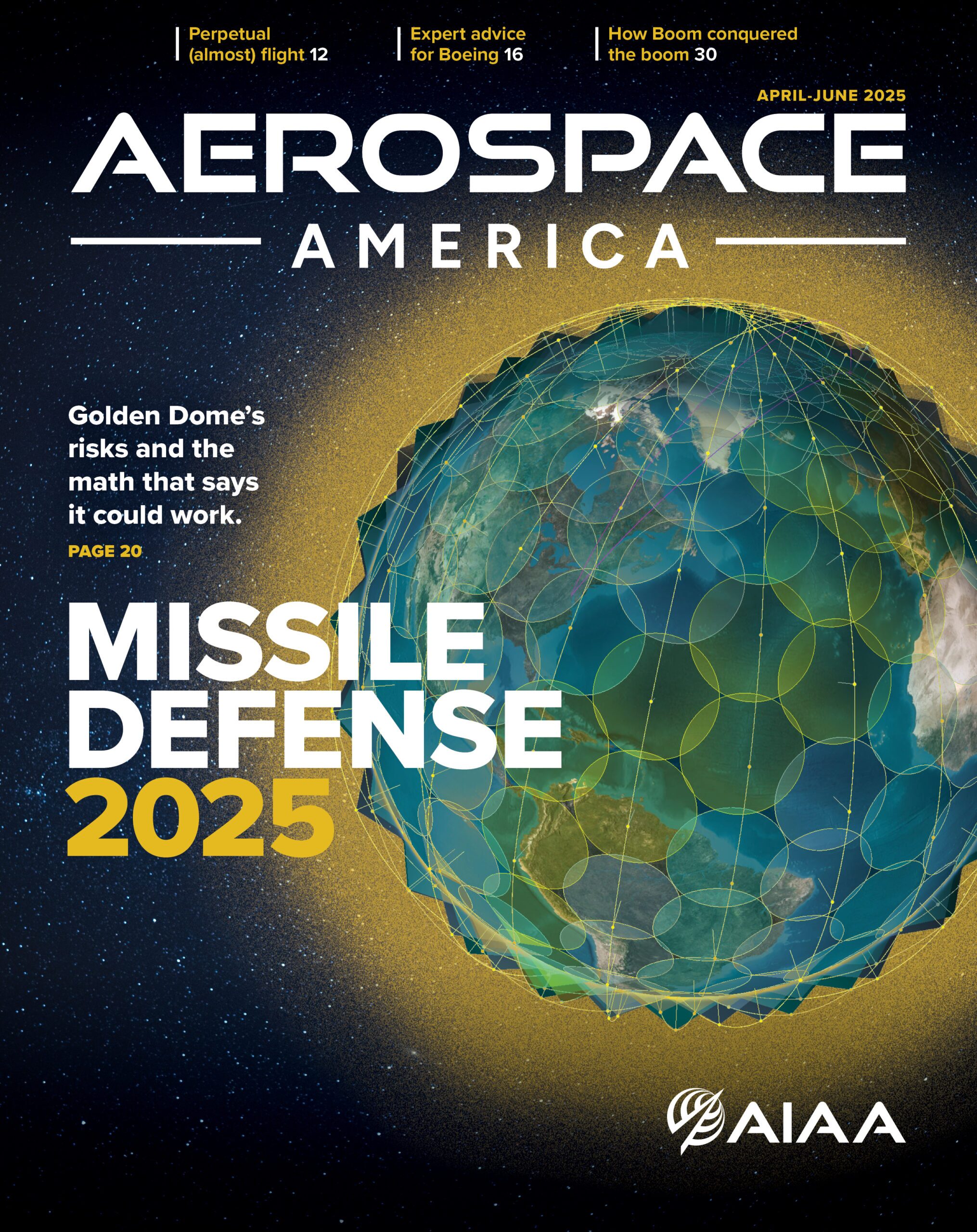
Stay Up to Date
Submit your email address to receive the latest industry and Aerospace America news.

The Artemis II Orion capsule photographed in March at NASA’s Kennedy Space Center in Florida. NASA/Rad Sinyak
KENNEDY SPACE CENTER, Florida — The four astronauts selected to fly around the moon for the 10-day Artemis II mission came here Wednesday to observe the ongoing work on their Orion capsule.
Stopping briefly to talk to the press, the crew — NASA’s Reid Wiseman, Victor Glover and Christina Koch, and Canadian astronaut Jeremy Hansen — expressed confidence in NASA’s planned approach to avoid a repeat of the Orion heat shield anomaly that occurred during the reentry phase of the 2022 Artemis I demonstration, in which an unoccupied Orion looped around the moon.
“The investigators discovered the root cause, which was the key” to understanding and solving the heat shield issue, said Wiseman, commander for Artemis II, which is scheduled to launch in April. “If we stick to the new reentry path that NASA has planned, then this heat shield will be safe to fly.”
The Artemis I capsule lost more heat shield material than predicted as it streaked through the atmosphere at the end of its 25-day flight, encountering temperatures up to 2,760 degrees Celsius (5,000 degrees Fahrenheit). Those high temperatures were not felt within the capsule and the shield otherwise worked as intended, but NASA doesn’t want the phenomena to repeat with astronauts on board.
In a post-flight analysis, investigators discovered that chunks of material blew off because gases and pressure built up inside the outer layer, known as Avcoat — gases that otherwise should have escaped. They did not, NASA concluded, because the heat shield temperature didn’t get high enough to create a bubbling, porous structure in the material. For future Orion capsules, manufacturer Lockheed Martin is adjusting the manufacturing process for the heat shield, but NASA opted not to modify the shield of the Artemis II capsule since it was already assembled. Instead, plans call for Artemis II to fly a modified reentry trajectory that will result in different heating of the shield and allow that outer layer to ablate.

The astronauts expressed confidence the issue was addressed. “This country now knows things about heat shields that they didn’t know they didn’t know,” said Hansen, one of two Artemis II mission specialists.
Koch, the other mission specialist, said she is confident about safety after meeting with teams of engineers and technicians who have worked on the capsule.
“At the end of the day, I know they are thinking about us and our families,” she said.
Glover, the Artemis II pilot, added: “This [Orion] vehicle has some new hardware, but a lot of it is the same, so we’re leaning on all of the lessons from Artemis I.”
NASA earlier this month completed fueling of the capsule, the agency’s Howard Hu said last week during a session at AIAA’s ASCEND conference in Las Vegas. Next, technicians will install the Launch Abort System motor stack on top of the capsule that would whisk the crew to safety if the Space Launch System rocket encounters an issue shortly after liftoff.
While that work is progressing, the crew has been running through two mission simulations per week, which is an “amazing cadence,” Wiseman said.
The Artemis II crew is to travel farther space than any humans have ventured since Apollo 13 in 1970. While en route to the moon, an oxygen tank on the capsule’s service module exploded, and the crew was forced to return to Earth without landing on the moon.
Artemis II is to loop around the far side, or dark side, of the moon, which may provide views of the lunar surface never seen before by the unaided human eye, Glover said. According to NASA’s mission profile, “Orion will be pulled back naturally by Earth’s gravity for the free return portion of the mission.”
The mission will conclude with a splashdown in the Pacific Ocean off the coast of San Diego.
“We still refer to great human accomplishments as moonshots, but the original moonshot effort is so far in our past now,” Glover said. “So this moonshot, it’s for our lifetime, to show that we can do those things.”
Associate Editor Cat Hofacker contributed to this report.
About paul brinkmann
Paul covers advanced air mobility, space launches and more for our website and the quarterly magazine. Paul joined us in 2022 and is based near Kennedy Space Center in Florida. He previously covered aerospace for United Press International and the Orlando Sentinel.
Related Posts
Stay Up to Date
Submit your email address to receive the latest industry and Aerospace America news.



